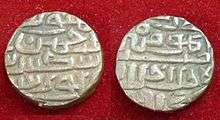Sikandar Lodi
| Sikandar Lodi | |
|---|---|
| Sultan of Delhi | |
| Reign | 17 July 1489 – 21 November 1517 |
| Coronation | 17 July 1489 |
| Predecessor | Bahlul Lodi |
| Successor | Ibrahim Lodi |
| Died | 21 November 1517 |
| Burial | Lodi Gardens, Delhi |
| Issue | Ibrahim Lodi |
| Dynasty | Lodi dynasty |
| Father | Bahlul Lodi |
| Religion | Islam |
Sikandar Lodi (died 21 November 1517), born Nizam Khan, was the Sultan of Delhi between 1489 and 1517.[1] He became the next ruler of the Lodi dynasty after the death of his father Bahlul Lodi in July 1489. The second and most successful ruler of the Lodi dynasty of the Delhi sultanate, he was also a poet of the Persian language and prepared a diwan of 9000 verses.[2]
Biography

Sikandar was the second son of Sultan Bahlul Khan Lodi and Bibi Ambha, the daughter of a Hindu goldsmith of Sirhind. He was of Afghan origin through his father.[3]
Sikandar was a capable ruler who encouraged trade across his territory, but discriminated against Hindu subjects. He expanded Lodi territory into the regions of Gwalior and Bihar. He made a treaty with Alauddin Hussain Shah and his kingdom of Bengal. In 1503, he commissioned the building of the present-day city of Agra. Agra was founded by him.[4]


References
- ↑ Sen, Sailendra (2013). A Textbook of Medieval Indian History. Primus Books. pp. 122–125. ISBN 978-9-38060-734-4.
- ↑ Ram Nath Sharma, History Of Education In India, Atlantic (1996), p. 61
- ↑ Lodī dynasty - Encyclopædia Britannica
- ↑ Kishori Saran Lal (1963). Twilight of the Sultanate. Asia Publishing House. p. 176. OCLC 500687579.
| Wikimedia Commons has media related to Sikandar Lodi. |
| Preceded by Bahlul Khan Lodi |
Sultan of Delhi 1489–1517 |
Succeeded by Ibrahim Lodi |